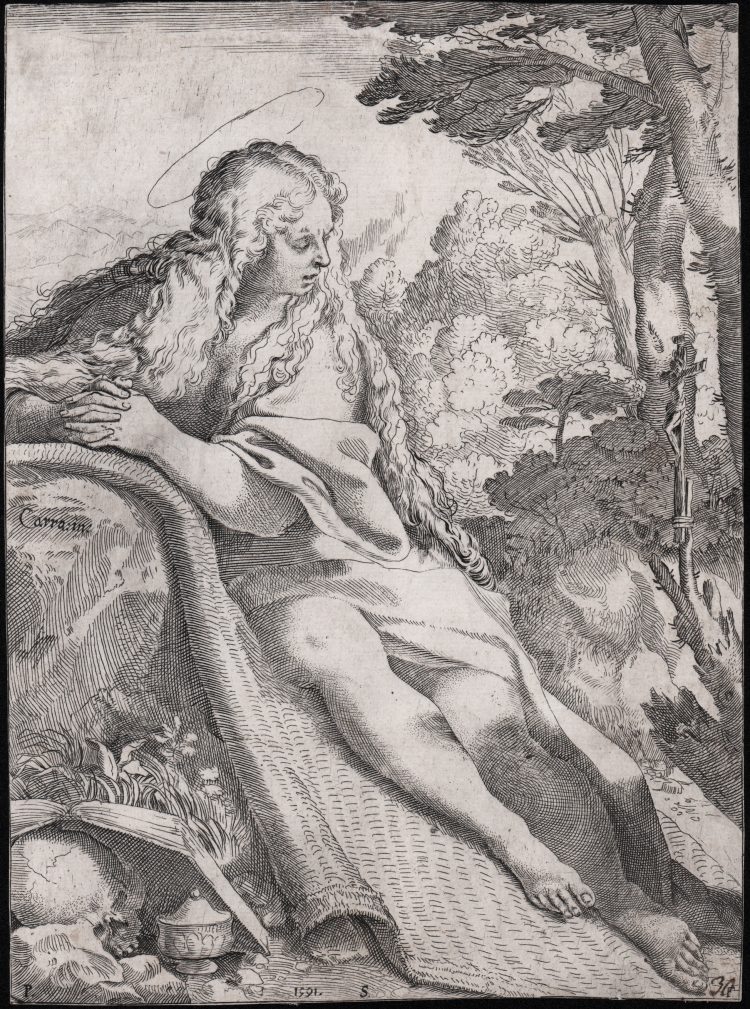




| Reference: | S30402 |
| Author | Annibale CARRACCI |
| Year: | 1591 |
| Measures: | 162 x 220 mm |



| Reference: | S30402 |
| Author | Annibale CARRACCI |
| Year: | 1591 |
| Measures: | 162 x 220 mm |
Etching, engraving, 1591, dated lower center and inscribed on the rock at left: 'Carra. in.'.
Example of second state, with the inscription P S F added in the lower margin. A fine impression on contemporary laid paper, trimmed to the platemark, very good conditions.
This etching demonstrates Annibale’s interest during the early 1590s in depicting a range of textures and dramatic contrasts of light and dark.
Two preparatory studies are mentioned by Bohn in TIB. In her opinion, the one in the Uffizi, inv. no. 18207F was probably an early idea for the print, with the basic conception already formulated but with a greater interest in landscape that was finally reduced in the print. The other drawing in the Louvre, inv. no. 7173, was Annibale's final design for the print, incised for transfer. The print relates most closely to a painting attributed to Pellegrino Tibaldi in the Pinacoteca, Lovere, which probably inspired Annibale's composition.
Another related painting is in Sir Denis Mahon's Collection, London, treats a similar composition in the same direction, but in horizontal rathen than vertical format. It is accepted by Mahon and tentatively by Bohlin as Annibale's autograph work, of ca. 1586-87.
Longhi consideres the painting a seventeenth century derivation from Annibale’s composition.
According to De Grazia, the figure of Magdalene is related to Venus in the painting Venus and Cupid by Annibale, in its turn modeled on the painting by Tintoretto Mars Driven Away From Peace and Abundance, and so, if the Mahon’s painting is actually by Annibale, the figure of Magdalene is inspired to Tintoretto.
A very good example.
|
Bartsch XVIII, 191, 16; Le Blanc, I p. 606, n. 16; Calvesi -Casale, Le incisioni dei Carracci, pp. 63 - 64, n. 203; TIB, 1996, 3906.014.S2; De Grazia, Le Stampe dei Carracci, p. 232 n.12. Dimensioni 162x220.
|
Annibale CARRACCI (Bologna 1560 - Roma 1609)
|
Younger brother of Agostino and cousin of Ludovico, who was also his teacher, Annibale is the leading figure of the XVII century school of Bologna and among the greatest artist of Italian Classicism.
The initial stage of his art was still very close to late Mannerism, tightly connected with Campi’s style. He then came to maturity, under an artistic point of view, drawing inspiration from the greatest artists of Italian Renaissance and he expressed the climax of his career in the frescoes inside Palazzo Farnese (1595-1604) in Rome, which are considered the highest example of Italian Classicism.
Following Agostino, he started to study engraving and etching; we can ascribe to him 17 prints, mainly with religious subjects. Just two of them bear a mythological subject in which it can be found once again the Alexandrine spirit of the mythological tale.
|
|
Bartsch XVIII, 191, 16; Le Blanc, I p. 606, n. 16; Calvesi -Casale, Le incisioni dei Carracci, pp. 63 - 64, n. 203; TIB, 1996, 3906.014.S2; De Grazia, Le Stampe dei Carracci, p. 232 n.12. Dimensioni 162x220.
|
Annibale CARRACCI (Bologna 1560 - Roma 1609)
|
Younger brother of Agostino and cousin of Ludovico, who was also his teacher, Annibale is the leading figure of the XVII century school of Bologna and among the greatest artist of Italian Classicism.
The initial stage of his art was still very close to late Mannerism, tightly connected with Campi’s style. He then came to maturity, under an artistic point of view, drawing inspiration from the greatest artists of Italian Renaissance and he expressed the climax of his career in the frescoes inside Palazzo Farnese (1595-1604) in Rome, which are considered the highest example of Italian Classicism.
Following Agostino, he started to study engraving and etching; we can ascribe to him 17 prints, mainly with religious subjects. Just two of them bear a mythological subject in which it can be found once again the Alexandrine spirit of the mythological tale.
|